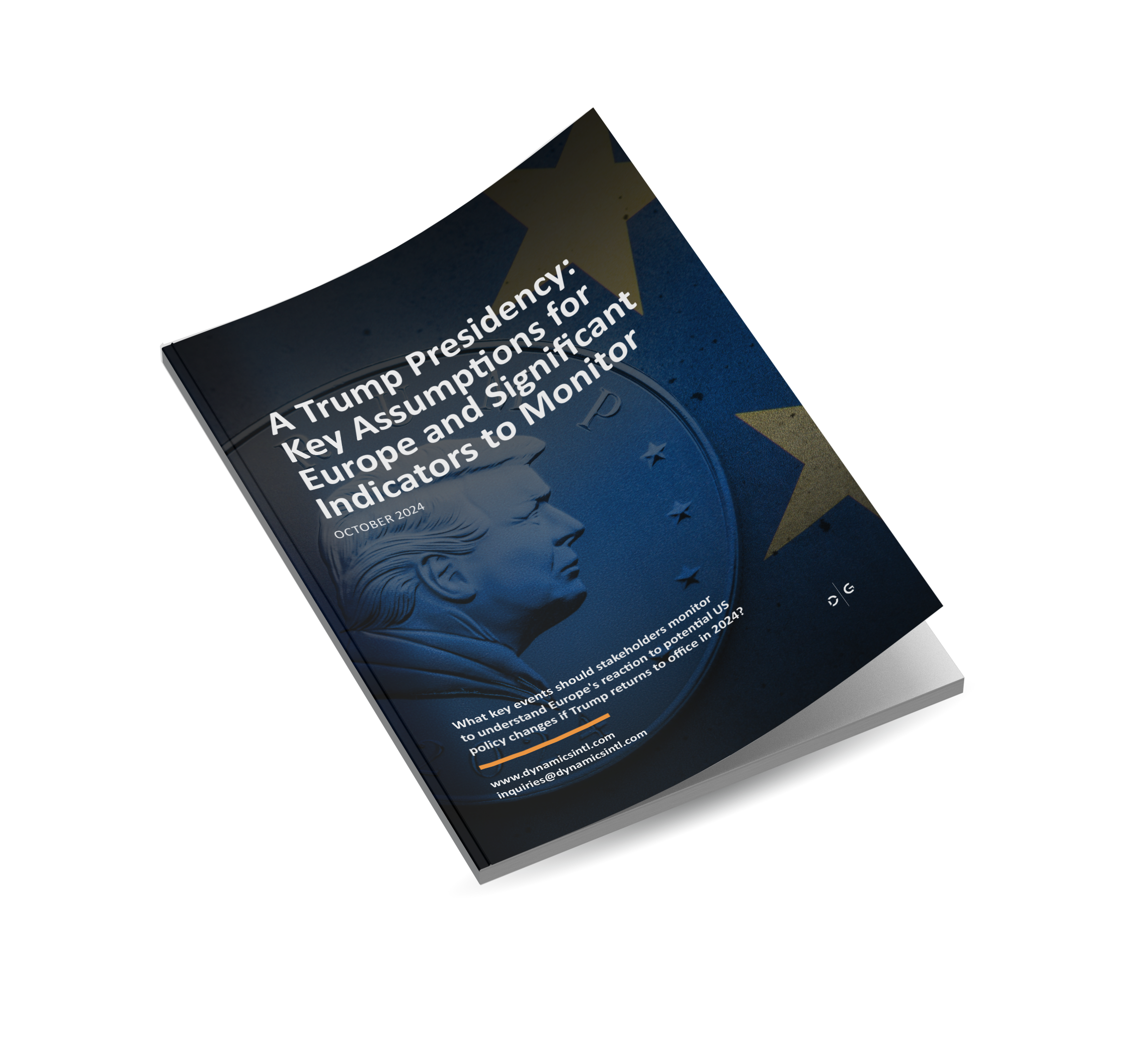As the 2024 US Presidential elections approach, the possibility of Trump returning to office alarms European leaders and global businesses. The potential repercussions necessitate a detailed assessment of key events to monitor, which will indicate how Europe might react to US policy changes.
The intelligence estimate provides stakeholders with insights into potential changes, geopolitical shifts, and new alliances post-election, affecting Europe’s investment climate, economic stability, and security. Designed for policymakers, corporate and political leaders, governments, business investors, and large corporations, this report highlights key indicators to monitor.
| Trade Tensions | An increase in tariffs and trade barriers, lead to trade wars and negatively impact EU exports, particularly in the electronics, automotive, and agriculture sectors. | • Announcements from the US Department of Commerce on new tariffs for EU products. • Increased lobbying by US industries affected by EU competition. • Retaliatory tariffs or trade restrictions from the EU. • Reports on declining export volumes in key EU sectors, such as automotive and electronics. • Statements from trade associations warning about the impact of trade barriers. |
| Damaged Transatlantic Relations | A renewed focus on "America First" policies compelling the EU to pilot a more unilateral and transactional "quid pro quo" approach from the US administration. | • Public statements from Trump administration officials emphasizing "America First" policies. • Diplomatic tensions or conflicts during EU-US summits and meetings. • Reduction in joint EU-US initiatives and cooperative agreements. • Increased bilateral agreements between individual EU countries and the US, bypassing the EU. • Media reports on strained negotiations between the EU and the US on key issues. |
| Increased Defense Spending Pressure | Increased pressure on NATO allies to boost defense spending impacting budgets for social programs and economic development. | • Public demands from Trump for NATO allies to meet the 2% GDP defense spending target. • Budget reports indicating increased defense allocations in EU member states. • Reallocations or cuts in social program funding to accommodate increased defense budgets. • Parliamentary debates and legislative actions focusing on defense spending. • Reports from defense contractors showing increased orders from EU countries. |
| Rise of Populist Movements and Anti-Immigration Policies | Trump's populist rhetoric is inspiring similar movements across Europe, challenging the EU's cohesion and policy direction. Trump strict anti-immigration stance influences European nations, exacerbating domestic conflicts with immigrants. | • Election victories or significant gains by populist and nationalist parties in EU member states. • Formation of new populist alliances within the European Parliament. • Increased public demonstrations and rallies led by populist groups. • Media coverage of anti-immigrant and Eurosceptic rhetoric in European political discourse. • Legislative proposals reflecting populist agendas gaining traction in national parliaments. |
| Shifts in Energy Policy | The US increases exports of oil and gas to Europe, positioning the region as its primary foreign buyer. Weaken the EU's "Green Agenda" and reassessment of overall EU energy policies. | • Announcements of new LNG export deals between the US and European countries. • Reports on increased US fossil fuel shipments to European ports. • Policy papers and public debates in the EU questioning the feasibility of current renewable energy targets. • Shifts in investments from renewable energy projects to fossil fuel infrastructure. • Statements from EU leaders acknowledging the need to balance energy security with environmental goals. • Concrete actions regarding a potential US withdrawal from the Paris Climate Agreement. |
| Supply Chains Disruption | Protectionist policies and trade barriers are disrupting existing EU supply chains. EU seeks alternative supply routes and suppliers, particularly for high-tech and energy sector. | • Reports on delays and increased costs in the import/export of critical goods. • Increased efforts by EU companies to diversify supply chains and reduce reliance on US suppliers. • Legislative actions within the EU to incentivize reshoring and local production. • Announcements of new trade agreements with countries in Asia and Africa. • Supply chain analysis reports highlighting vulnerabilities and disruptions. |
| Disputes to Digital and Technological Cooperation | Diminished cooperation on technology and digital innovation. EU's prompting to bolster investments in technological infrastructure and pursue new partnerships beyond the US. | • Termination or reduction of joint US-EU research and development projects. • Increased funding allocations for EU digital and technological initiatives. • Formation of new technology partnerships with East Asian countries. • Reports from EU tech companies on the effect of reduced US collaboration. • Policy announcements focused on enhancing EU technological independence. |
| Economic Uncertainty | Economic uncertainty within the EU, driven by fluctuating external conditions and reduced foreign investments, impacting job producing social unrest | • Decline in foreign direct investment inflows into the EU. • Economic forecasts indicate slower growth rates and increased volatility. • Reports of major companies scaling back operations or relocating outside the EU. • Rising unemployment rates and reduced job creation figures. • Public protests and social unrest linked to economic dissatisfaction. |
| Emphasis on Strategic Autonomy | A reduced US commitment to NATO, and the EU advance to achieve strategic autonomy. This impact joint policies and actions toward major global players such as Russia and China. | • Increased EU defense spending and development of independent military capabilities. • Policy papers and public statements highlight the importance of EU strategic autonomy. • Formation of new security alliances and partnerships within the EU framework. • Reduction in joint EU-US military exercises and operations. • Enhanced cooperation among EU member states on defense and foreign policy initiatives. |
In conclusion, the potential re-election of Trump in 2024 raises concerns for European leaders and global businesses. This estimate identifies key indicators to monitor, providing stakeholders with a strategic overview of potential changes and geopolitical shifts. By monitoring these indicators, stakeholders can make informed decisions and strategic plans to mitigate the risks of the evolving global system.

ARTICLE | 9 PAGES




